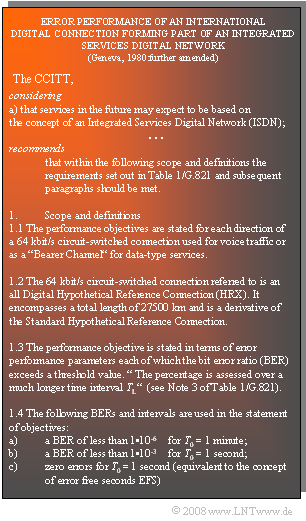Every operator of ISDN systems must comply with certain minimum requirements regarding the bit error rate $\rm (BER)$, which are specified for example in the CCITT Recommendation G.821 under the name "Error Performance".
On the right you can see an excerpt from this recommendation:
- This states, among other things, that – averaged over a sufficiently long time – at least $99.8\%$ of all one-second intervals must have a bit error rate less than $10^{-3}$ (one per thousand).
- For a bit rate of $\text{64 kbit/s}$ this corresponds to the condition that in one second $($and thus for $N = 64\hspace{0.08cm}000$ transmitted symbols$)$ no more than $64$ bit errors may occur:
- $$\rm Pr(\it f \le \rm 64) \ge \rm 0.998.$$
Hints:
- The exercise belongs to the chapter Gaussian distributed random variables.
- Always assume bit error probability $p = 10^{-3}$ for the first three subtasks.
- In addition, throughout the task, let $N = 64\hspace{0.08cm}000$ hold.
- Under certain conditions – which are all fulfilled here – the binomial distribution can be approximated by a Gaussian distribution with equal mean and equal standard deviation. Use this approximation for the subtask (4).
Questions
Solution
(1) Both statements are correct:
- The random vairable $f$ defined here is the classical case of a binomially distributed random variable: Sum over $N$ binary values $(0$ or $1)$.
- Because the product $N \cdot p = 64$ and thus is much larger than $1$ ,
- the binomial distribution can be approximated with good approximation by a Poisson distribution with rate ${\it \lambda} = 64$ .
(2) The mean is obtained as $m_f = N \cdot p \hspace{0.15cm}\underline{= 64}$ regardless of whether one assumes the binomial distribution or the Poisson distribution.
(3) For the standard deviation one obtains
- $$\it \sigma_f=\rm\sqrt{\rm 64000\cdot 10^{-3}\cdot 0.999}\hspace{0.15cm}\underline{\approx\sqrt{64}=8}.$$
- The error by applying Poisson distribution instead of binomial distribution here is smaller than $0.05\%$.
(4) For a Gaussian random variable $f$ with mean $m_f {= 64}$ the probability ${\rm Pr}(f \le 64) \hspace{0.15cm}\underline{\approx 50\%}$. Note:
- For a continuous random size, the probability would be exactly $50\%$.
- Since $f$ can only take integer values, it is slightly larger here.
(5) With $\lambda = N \cdot p$ the corresponding condition is:
- $$\rm Q\big (\frac{\rm 64-\it \lambda}{\sqrt{\it \lambda}} \big )\le \rm 0.002\hspace{0.5cm}\rm or \hspace{0.5cm}\frac{\rm 64-\it \lambda}{\sqrt{\it \lambda}}>\rm 2.9.$$
- The maximum value of $\lambda$ can be determined according to the following equation:
- $$ \lambda+\rm 2.9\cdot\sqrt{\it\lambda}-\rm 64 = \rm 0.$$
- The solution of this quadratic equation is thus:
- $$\sqrt{\it \lambda}=\frac{\rm -2.9\pm\rm\sqrt{\rm 8.41+256}}{\rm 2}=\rm 6.68 \hspace{0.5cm}\rightarrow \hspace{0.5cm} \lambda = 44.6 \hspace{0.5cm}\Rightarrow \hspace{0.5cm} {\it p}_\text{B, max}= \frac{44.6}{64000} \hspace{0.15cm}\underline{\approx 0.069\%}.$$
- The second solution is negative and need not be considered further.
